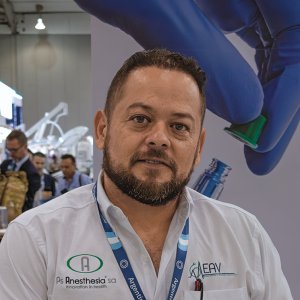Improving System Efficiency Through Bed Technology

STORY INLINE POST
Q: What market opportunities have you identified in the Mexican population regarding epidemiology and social trends?
A: We want to improve and amplify markets like geriatric care. Between 1990 and 2017, the percentage of adults over 60 years old in Mexico rose from 6.4 percent to 10.5 percent. This social evolution requires changes in healthcare since there are no precise public policies regarding who is responsible for providing care to this population in Mexico.
We are interested in focusing our technology on home care. We have developed specialized beds to this end and we want to make them available to the public. These beds can prevent a significant number of fractures caused by falls, with safety devices to protect the patient. The beds can also reach a very high height, so when the patient lies down it is easier for the caregiver to perform activities like changing the sheets.
We are waiting for a regulation from the Ministry of Health and the National Geriatrics Institute (INGER) that specifies the infrastructure required in homes and specialized institutions. Meanwhile, we want to reach caregivers, nurses and families who have someone at home with mobility problems and also residences so they can improve their offer and provide the best care.
Q: How does Linet contribute to the treatment of chronic diseases?
A: Chronic diseases such as diabetes, obesity and renal insufficiency are impacting the Mexican population. With the purchase of BORCAD Medical in 2016, Linet acquired a solution to alleviate the impact of kidney failure: special chairs that provide a more comfortable experience as patients receive their treatment and which can be used to provide treatment in places that do not have the necessary infrastructure.
We also have a line of beds for gynecology and obstetrics that we presented in July 2017 at the Mexican Congress of Gynecology and Obstetrics.
Q: What is the status of your goal to establish a plant in Tijuana?
A: The opening of a manufacturing plant in Mexico through which we can distribute both to the US and Latin America remains one of our objectives. We hope that the economic relationship between the US and Mexico stabilizes so that we can finally make a decision on this project. We are still thinking about locating it in Tijuana, because this location offers the best opportunities in terms of logistics, costs and supply chain.
Q: Where do you see the greatest opportunities in Mexico?
A: The public market will remain the largest. IMSS has said that it is receiving more funds to develop infrastructure and to take care of the new rightsholders; however, the institution still needs more beds. The private sector is also very interesting as it requires a different strategy. It is more B2C than B2B, but we need to improve to provide the services we want and to achieve the growth we expect.
Q: How does Linet technology contribute to improving the efficiency of the Mexican healthcare system?
A: In the public sector there is a large installed equipment base, although almost half is obsolete. The inclusion of new beds will help public institutions reduce the time that patients stay in hospital. The reason for that is that better materials are much less prone to cause infections and can help patients prevent the development of ulcers caused by pressure.
With our technology for ICU beds, it is possible to reduce the length of stay in one of the most expensive areas in a hospital. In addition, technology helps to reduce complications like pneumonia, caused by mechanical ventilation with automatic lateralization. We are also thinking about the safety of patients and the professionals who help them.
We are pleased that both in Mexico and the world, people recognize the importance of beds in the recovery of a patient. Hospitals and healthcare systems now see it as a medical device, not as a piece of furniture.
Q: What is the purpose of each line?
A: Our portfolio is called ICU Complete and its purpose is to show that there are complete solutions for the intensive care area. The portfolio consists of four categories of beds: Alive, Safe, Recover and Well. In ICU Alive, we develop beds with features that are focused on the vital functions of the patient. For example, Alive beds have a Smart CPR, a button that commands the bed to go into position for CPR. These beds also have a chamber where the digital detector is placed for X-ray imaging. When patients are in ICU they cannot move which might cause them to accumulate liquids in their lungs and eventually this situation can lead to pneumonia. The bed allows lateral movements for the patietn that help prevent the gathering of liquids.
The second category is ICU Safe and its objective is the prevention of ulcers, respiratory complications and falls. The three beds in this category have technologies like active mattresses that inflate and deflate in different sections with different frequencies, so the pressure is not transmitted to one place on the body. Also, to avoid falls, beds have several types of alarms that warn of various risks that may threaten the wellbeing of the patient.
The third line is ICU Recover, which provides a support system in each of the bed's three adjustable levels. These beds include mechanical devices that help nurses and caregivers move the patient, an important contribution to their physical health.
The fourth category focuses on helping nurses and doctors to execute tasks that are common in the ICU. The three beds in this category incorporate scales to load the patient more easily into the bed and pedals that help professionals climb into the bed to help or move their patient if the nurses or doctors have their hands busy at the time. They also include lateralization and high- security guardrails to help nurses and caregivers when changing sheets or when it becomes necessaary to move the patient. All our beds fully comply with the relevant European norm, which is the strictest in terms of hospital security.
Q: How do you train workers to use these technologies?
A: One of the main reasons for our success in the region is that in our team, we have nurses who come to each facility to train users on all the applications. When clients buy from us they do not only buy a product, but also acquire the complete support system of the organization. Our training team teaches doctors and nurses how to perform all their activities in the new beds, how to clean them and how to use the technology.
Q: What are the commercial objectives of this offer?
A: This campaign is mostly oriented to the private market. In the public market we have done very well. Last year, we sold more than 1,000 ICU beds but we believe the market is no bigger than 1,200 per year. From those 1,000 beds around 990 went to the public sector as private institutions are not investing in this. We are trying to make this offer technologically, clinically and commercially interesting. The plan is to reach them with high-end technology at an attractive price.
Q: What are the company’s expectations in Mexico?
A: We want to continue leading the market in hospitalization and ICU beds. We want to have 100 percent coverage of the Mexican territory and Latin America. The company also wants to compete and achieve a leadership position in geriatric and chronic home care and in gynecology beds. Finally, we want to establish as an intrinsic experience a continued high-quality aftersales service. With these goals in mind we will continue growing.






















